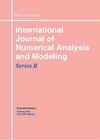解决三维椭圆界面问题的直接方法
IF 0.7
4区 数学
Q1 MATHEMATICS
International Journal of Numerical Analysis and Modeling
Pub Date : 2024-05-01
DOI:10.4208/ijnam2024-1014
引用次数: 0
摘要
本文提出了一种直接方法,用于高效求解具有片断常数系数的三维椭圆界面问题,该问题具有跨界面的有限跳跃。计算框架依赖于在统一笛卡尔网格系统上实施的有限差分方案。通过对远离界面的网格点使用七点拉普拉斯,我们的方法只需要对位于界面附近或界面上的网格点进行系数修改。数值实验验证了我们的方法的有效性。一般来说,我们的方法在求解及其梯度方面都能达到二阶精度(以最大规范衡量),尤其是在系数跳变适中的情况下非常有效。在 [1] 最近关于一维和二维椭圆界面的研究基础上,我们的方法成功地引入了一种更简单的方法,并将其扩展到三维空间。值得注意的是,我们提出的方法不仅具有高效性和准确性,还增强了实现的简便性,使该领域的非专业人员也能使用。本文章由计算机程序翻译,如有差异,请以英文原文为准。
A Direct Method for Solving Three-Dimensional Elliptic Interface Problems
This paper presents a direct method for efficiently solving three-dimensional elliptic
interface problems featuring piecewise constant coefficients with a finite jump across the interface.
A key advantage of our approach lies in its avoidance of augmented variables, distinguishing
it from traditional methods. The computational framework relies on a finite difference scheme
implemented on a uniform Cartesian grid system. By utilizing a seven-point Laplacian for grid
points away from the interface, our method only requires coefficient modifications for grid points
located near or on the interface. Numerical experiments validate our method’s effectiveness.
Generally, it achieves second-order accuracy for both the solution and its gradient, measured in
the maximum norm, particularly effective in scenarios with moderate coefficient jumps. Extending
and building upon the recent work of [1] on 1D and 2D elliptic interfaces, our approach successfully
introduces a simpler method for extension into three dimensions. Notably, our proposed method
not only offers efficiency and accuracy but also enhances the simplicity of implementation, making
it accessible to non-experts in the field.
求助全文
通过发布文献求助,成功后即可免费获取论文全文。
去求助
来源期刊
CiteScore
2.10
自引率
9.10%
发文量
1
审稿时长
6-12 weeks
期刊介绍:
The journal is directed to the broad spectrum of researchers in numerical methods throughout science and engineering, and publishes high quality original papers in all fields of numerical analysis and mathematical modeling including: numerical differential equations, scientific computing, linear algebra, control, optimization, and related areas of engineering and scientific applications. The journal welcomes the contribution of original developments of numerical methods, mathematical analysis leading to better understanding of the existing algorithms, and applications of numerical techniques to real engineering and scientific problems. Rigorous studies of the convergence of algorithms, their accuracy and stability, and their computational complexity are appropriate for this journal. Papers addressing new numerical algorithms and techniques, demonstrating the potential of some novel ideas, describing experiments involving new models and simulations for practical problems are also suitable topics for the journal. The journal welcomes survey articles which summarize state of art knowledge and present open problems of particular numerical techniques and mathematical models.

 求助内容:
求助内容: 应助结果提醒方式:
应助结果提醒方式:


